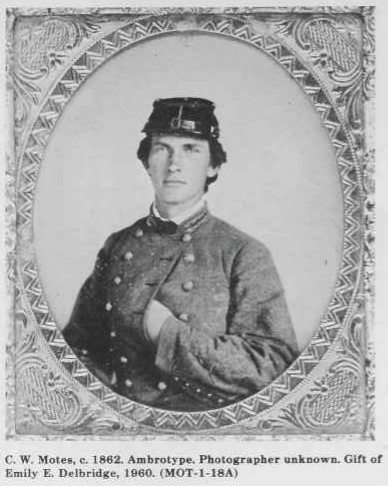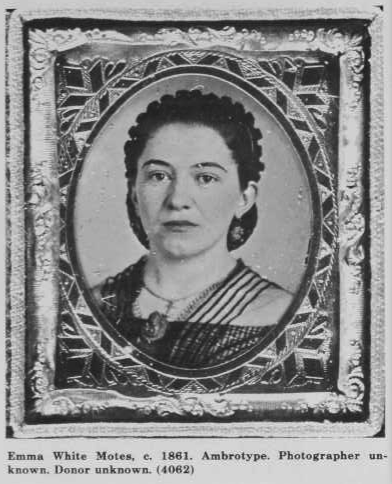Lt Columbus W. Motes, his horse, &etc
2 April 2024
A 25 year old professional photographer from Athens, GA, Columbus Washington Motes was First Lieutenant and commanded a section – two rifled guns – of the Troup (Georgia) Artillery on the Maryland Campaign of 1862. On 14 September he helped muscle his guns to the crest of Elk Ridge then down the ridge to Maryland Heights overlooking Harpers Ferry, where they contributed to the bombardment of the Federal positions in and around the town. The garrison surrendered the next day.
He fought his guns again near the Dunker Church at Sharpsburg on the 17th. He was seriously wounded there, at first refusing to leave the field. As his Captain Henry H. Carlton later remembered it:
[H]e came to me, his arm dangling by his side, and covered with blood and said: “Captain Carlton, what do you think? The yankees have shot me!” I ordered him to the rear, but he returned to his post, and in a few moments I heard: “Captain Carlton, the yankees have shot me again!” This time he was badly wounded in the hip, and was borne to the rear on a caisson.
He had recovered and returned to duty by the end of the year, and on 3 January 1863 the other three officers of the battery, Captain Carlton and Lieutenants Jennings and Newton constituted a Board of Survey and Appointment “to assess the value of a horse belonging to Lt Motes which was killed in action @Sharpsburg Md Sept. 17th, 1862.”
The findings of the Board (they filled in “Two Hundred” as the amount, which is hard to read) as approved by brigade commander Wofford:
He did collect the $200 for his horse, late in 1863, by which time good horses were worth as much as 10 times that amount. I do not know what he paid for a replacement.
Lieutenant Motes was probably carrying this image of his sweetheart in Maryland, as he apparently did through the war:
She’s Emily F “Emma” White, also of Athens. Motes was briefly married before the war and had a daughter born in 1857, but his wife died by 1861. He married Emma shortly after the war, in 1866, and they spent most of the rest of their lives making photographs in Atlanta.
Notes
Thanks to Jim Rosebrock for the pointer to Lieutenant Motes in his excellent book Artillery of Antietam (2023), published by the Antietam Institute, which got me started on the Lieutenant.
The Carlton quote above is from the Atlanta Constitution of 11 May 1890, when Carlton was US Congressman from Georgia.
The findings of the Board of officers is from Motes’ Compiled Service Record jacket at the National Archives; I found it online from fold3.
The ambrotypes of Columbus and Emma, above, are from the Atlanta Historical Society’s Journal of Summer, 1981. The text accompanying them on pages 42 and 43 reads:
C.W. Motes (1837-1919) and Emma White Motes (c.1830- c.1890)
” . . . a small red morocco case, containing a Collodion portrait ofthe girl he left behind him, was valued by him above gold and precious stones.” Written in 1855 to describe a soldier of the Crimea and the photograph he carried with him, this quotation could as easily have been ascribed to soldiers of the American Civil War and the photographs of loved ones that they carried. Columbus W. Motes of Athens, Georgia, a first lieutenant, then captain [sic], with the Troup County Artillery, carried a small ninth-plate ambrotype with him throughout the war. “Presented by Miss Emma White, 1861,” the photograph carries with it the almost traditional tale of having halted bullets intended for its bearer. Miss White’s ambrotype survived the war in excellent condition and was brought to Atlanta one decade later by the captain and Emma, who were married in 1866.
While in Athens, Motes, an artist, had begun the business of photography with a man named White, possibly Emma’s brother or father. The photographs reproduced here may have been taken in Athens. It was the photography business that C.W. Motes continued, probably with Emma’s help, in Atlanta in 1872 in a gallery on Whitehall Street, “a favorite resort with lovers of art.” One Atlanta newspaper account written soon after the Moteses’ arrival posed the question of “the real” versus “the ideal” when advising its readers, “whether comely or homely,” to call on Captain Motes, who could “make a very homely face look passable.”
In the 1880s, Motes was awarded a bronze medal in a New York competition for photographs created through a short-lived photographic process called the “chromatype.” He was also known for his photographic sculpture using people posed in well-known scenes from literature and mythology. In 1895 Motes won additional prizes for his photographs exhibited at the Cotton States and International Exposition. Before his death in 1919, he had become one of the city’s most popular portrait photographers. Doing a brisk business until 1907, the Motes gallery survived fire, changes in the public’s taste, and changes in photographic processes to become one of Atlanta’s most successful photography shops.





Please Leave a Reply